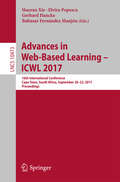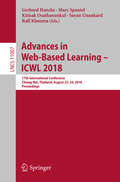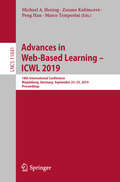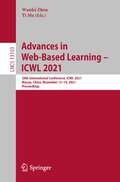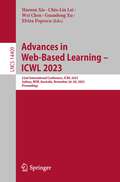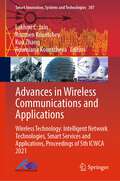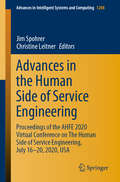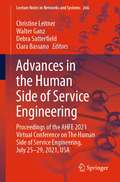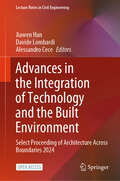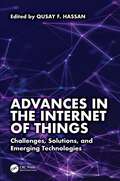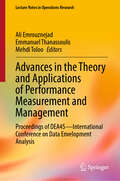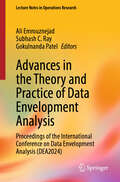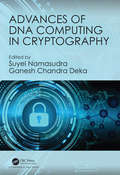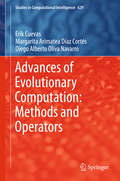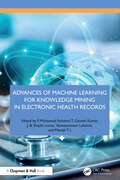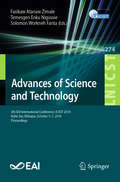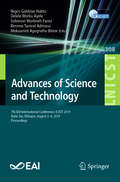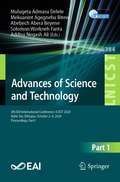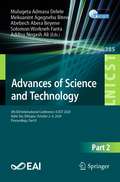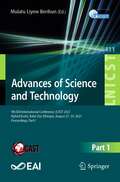- Table View
- List View
Advances in Web-Based Learning – ICWL 2017: 16th International Conference, Cape Town, South Africa, September 20-22, 2017, Proceedings (Lecture Notes in Computer Science #10473)
by Baltasar Fernández Manjón Elvira Popescu Haoran Xie Gerhard HanckeThis book constitutes the proceedings of the 16th International Conference on Web-Based Learning, ICWL 2017, held in Cape Town, South Africa, in September 2017. The 13 revised full papers presented together with 9 short papers and 3 poster papers were carefully reviewed and selected from 56 submissions. The papers are organized in topical sections on Inquiry-Based Learning and Gamification; Learning Analytics; Social Media and Web 2. 0-based Learning Environments; Assessment and Accessibility in Higher Education; Open Educational Resources and Recommender Systems; and Practice and Experience Sharing.
Advances in Web-Based Learning – ICWL 2018: 17th International Conference, Chiang Mai, Thailand, August 22-24, 2018, Proceedings (Lecture Notes in Computer Science #11007)
by Ralf Klamma Marc Spaniol Gerhard Hancke Kitisak Osathanunkul Sayan UnankardThis book constitutes the proceedings of the 17th International Conference on Web-Based Learning, ICWL 2018, held in Chiang Mai, Thailand, in August 2018.The 11 revised full papers presented together with 4 short papers were carefully reviewed and selected from 37 submissions. The papers are organized in topical sections on learning assessment and behavior; case studies; augmented reality and collaborative learning; game-based learning; and learning content management and experience sharing.
Advances in Web-Based Learning – ICWL 2019: 18th International Conference, Magdeburg, Germany, September 23–25, 2019, Proceedings (Lecture Notes in Computer Science #11841)
by Marco Temperini Michael A. Herzog Zuzana Kubincová Peng HanThis book constitutes the proceedings of the 18th International Conference on Advances in Web-Based Learning, ICWL 2019, held in Magdeburg, Germany, in September 2019. The 15 full, 15 short, and 7 poster papers presented in this volume were carefully reviewed and selected from 68 submissions. The contributions were organized in topical sections named: Semantic Web for E-Learning, Learning Analytics, Computer Supported Collaborative Learning, Assessment and Pedagogical Issues, E-learning Platforms and Tools, Mobile Learning, and Poster Papers.
Advances in Web-Based Learning – ICWL 2021: 20th International Conference, ICWL 2021, Macau, China, November 13–14, 2021, Proceedings (Lecture Notes in Computer Science #13103)
by Wanlei Zhou Yi MuThis book constitutes the proceedings of the 20th International Conference on Advances in Web-Based Learning, ICWL 2021, which was held in Macau, China, in November 2021. The papers included in this volume deal with multiple topics, from algorithms to systems and applications and are organized in 3 tracks: Online learning methodologies, trust, and analysis; Online learning environment with tools; Online learning privacy issues and special tools.
Advances in Web-Based Learning – ICWL 2023: 22nd International Conference, ICWL 2023, Sydney, NSW, Australia, November 26–28, 2023, Proceedings (Lecture Notes in Computer Science #14409)
by Wei Chen Guandong Xu Elvira Popescu Haoran Xie Chiu-Lin LaiThis book constitutes the proceedings of the International Conference on Web-Based Learning, ICWL 2023, in Sydney, NSW, Australia, in November 2023.The 9 full papers together with 7 short papers included in this volume were carefully reviewed and selected from 23 submissions. The conference focuses on subjects such as Semantic Web for E-Learning, through Learning Analytics, Computer-Supported Collaborative Learning, Assessment, Pedagogical Issues, E-learning Platforms, and Tools, to Mobile Learning.
Advances in Wireless Communications and Applications: Smart Communications: Interactive Methods and Intelligent Algorithms, Proceedings of 3rd ICWCA 2019 (Smart Innovation, Systems and Technologies #190)
by Srikanta Patnaik Margarita Favorskaya Roumen Kountchev Aniket Mahanti Shen ChongThis book features selected papers presented at the 3rd International Conference on Wireless Communications and Applications (ICWCA 2019), held at Hainan University, China. Focusing on applications of the latest smart theories and approaches, and recent advances in the field, it covers topics such as OFDM and multi-carrier techniques; smart antenna and space-time signal processing; MIMO, multi-user MIMO, and massive MIMO; modulation, coding, and diversity techniques; dynamic spectrum access and cognitive radio; interference management and radio resource allocation; equalization techniques; synchronization, estimation, and detection techniques; and wireless multiple access (e.g. CDMA, OFDMA, NOMA, ).
Advances in Wireless Communications and Applications: Smart Wireless Communications: Algorithms and Network Technologies, Proceedings of 5th ICWCA 2021 (Smart Innovation, Systems and Technologies #299)
by Lakhmi C. Jain Roumen Kountchev Kun Zhang Roumiana KountchevaThis book features selected papers presented at the 5th International Conference on Wireless Communications and Applications (ICWCA 2021), held at Hainan University, China. The book will focus on the presentation of the newest trends and achievements in the development of intelligent algorithms and network technologies in smart communications, with application in underwater communications, IoT-based marine surface communications as well as state-of-the-art real-time precise location technologies, Wi-Fi/Bluetooth locationing, array signal processing, and many others.
Advances in Wireless Communications and Applications: Wireless Technology: Intelligent Network Technologies, Smart Services and Applications, Proceedings of 3rd ICWCA 2019 (Smart Innovation, Systems and Technologies #191)
by Srikanta Patnaik Margarita Favorskaya Roumen Kountchev Aniket Mahanti Shen ChongThis book gathers selected papers presented at the 3rd International Conference on Wireless Communications and Applications (ICWCA 2019), held at Hainan University, China. It covers up-to-date smart theories and approaches, as reflected in contemporary technical achievements in the area. The topics covered include: software-defined networking (SDN) and network function virtualization (NFV), future data center networks, 5G/6G mobile networks, QoS/QoE support in future networks, future Internet of things (IoT) networks, network fault management and service availability, and many others.
Advances in Wireless Communications and Applications: Wireless Technology: Intelligent Network Technologies, Smart Services and Applications, Proceedings of 5th ICWCA 2021 (Smart Innovation, Systems and Technologies #307)
by Lakhmi C. Jain Roumen Kountchev Kun Zhang Roumiana KountchevaThis book features selected papers presented at the 5th International Conference on Wireless Communications and Applications (ICWCA 2021), held at Hainan University, China. The book will focus on the presentation of the newest trends and achievements in the development of intelligent algorithms and network technologies in smart communications, with application in underwater communications, IoT-based marine surface communications as well as state-of-the-art real-time precise location technologies, WiFi/Bluetooth locationing, array signal processing and many others.
Advances in Wireless Sensor Networks: The 8th China Conference, CWSN 2014, Xi'an, China, October 31--November 2, 2014. Revised Selected Papers (Communications in Computer and Information Science #501)
by Wei Wang Limin Sun Huadong Ma Dingyi Fang Jinping NiuThis book constitutes the refereed proceedings of the 8th China Conference of Wireless Sensor Networks, held in Xi'an, China, in October/November 2014. The 64 revised full papers were carefully reviewed and selected from 365 submissions. The papers are organized in topical sections on power control and management; network architecture and deployment; positioning and location-based services in wireless sensor networks; security and privacy; wireless communication systems and protocols; routing algorithm and transport protocols in wireless sensor networks; wireless communication protocols and sensor data quality, integrity and trustworthiness; Internet of Things; wireless mobile network architecture, in-vehicle network; indoor positioning and location-based services; applications of wireless sensor networks.
Advances in the Human Side of Service Engineering: Proceedings of the AHFE 2020 Virtual Conference on The Human Side of Service Engineering, July 16-20, 2020, USA (Advances in Intelligent Systems and Computing #1208)
by Jim Spohrer Christine LeitnerThis book reports on cutting-edge research and best practices in developing innovative service systems. It covers issues concerning the suitability of a given system for human use, human services, and excellent human experiences. It explores a wide range of ways in which human factors in engineering, ergonomics, human–computer interaction (HCI), cognitive engineering, and many other disciplines can contribute to the design and management of service systems. It considers aspects related to cost effectiveness, ethics, and privacy, among others, and covers applications in many areas, from healthcare to education, transportation, and the economy. Based on the AHFE 2020 Virtual Conference on the Human Side of Service Engineering, held on July 16–20, 2020, the book provides readers with a comprehensive overview of current research and future challenges in the field of service engineering, together with practical insights into the development of innovative services for various kinds of organizations.
Advances in the Human Side of Service Engineering: Proceedings of the AHFE 2021 Virtual Conference on The Human Side of Service Engineering, July 25-29, 2021, USA (Lecture Notes in Networks and Systems #266)
by Walter Ganz Clara Bassano Christine Leitner Debra SatterfieldThis book reports on cutting-edge research and best practices in developing innovative service systems. It covers issues concerning the suitability of a given system for human use, human services, and excellent human experiences. It explores a wide range of ways in which human factors in engineering, ergonomics, human–computer interaction (HCI), cognitive engineering, and many other disciplines can contribute to the design and management of service systems. It considers aspects related to cost effectiveness, ethics, and privacy, among others, and covers applications in many areas, from healthcare to education, transportation, and the economy. Based on the AHFE 2021 Conference on the Human Side of Service Engineering, held virtually on 25–29 July, 2021, from USA, this book provides readers with a comprehensive overview of current research and future challenges in the field of service engineering, together with practical insights into the development of innovative services for various kinds of organizations.
Advances in the Integration of Technology and the Built Environment: Select Proceeding of Architecture Across Boundaries 2024 (Lecture Notes in Civil Engineering #593)
by Jiawen Han Davide Lombardi Alessandro CeceThis open access book will be a compilation of selected papers from the 2nd International Conference on Architecture Across Boundaries (AAB2024). The work focuses on novel integration of technology into the built environment in the areas of space syntax, digital fabrication, computational design, professional models, eco-system and urban morphology domains. The content makes valuable contributions to academic researchers and educators in the university and practitioners in the industry, who have been working in or with a particular awareness of the different types of boundaries, including technological, cultural and physical boundaries in the research on built environments. This book will work as a good reference for academics and professionals conducting interdisciplinary research in an effort to understand and achieve a better hybrid environment.
Advances in the Internet of Things: Challenges, Solutions, and Emerging Technologies
by Qusay F. HassanMany reports estimated that in 2024, the number of Internet of Things (IoT) devices exceeded 18 billion worldwide, with predictions suggesting that it could reach nearly 40 billion by 2033. Despite primarily being consumer devices, a growing number of them will find use in industrial and enterprise applications. This shows the significance of IoT and how it shapes the future. However, to realize its full potential, we must address its emerging challenges and highlight recent applications, advances, and trends, which is the focus of this book.Security and privacy represent some of the key challenges IoT adopters face. The severity of these issues is exacerbated by the growing number of IoT devices, the expansion of Industry 4.0 (and the emergence of Industry 5.0), and the significant increase in cybersecurity attacks. Considering that ensuring security and privacy is crucial for the successful adoption of IoT, this book dedicates several chapters to these areas. This book also introduces some novel models that improve IoT environments and presents several practical implementations that utilize IoT to demonstrate some of its real‑world applications. Furthermore, it examines several emerging technologies that enable the realization of advanced IoT environments. We see most IoT advances in three main areas: the integration of artificial intelligence/machine learning, network technologies, and hardware design. Therefore, this book dedicates several chapters to these areas. Most chapters touch on artificial intelligence/machine learning, emphasizing the significance of these technologies in today’s and next‑eneration applications.The main objective of this book is to capture the state of the art in IoT and explore some of its emerging challenges, solutions, and technologies. This peer‑eviewed book serves as a reference for researchers, academics, practitioners, and graduate‑evel students.
Advances in the Theory and Applications of Performance Measurement and Management: Proceedings of DEA45—International Conference on Data Envelopment Analysis (Lecture Notes in Operations Research)
by Ali Emrouznejad Emmanuel Thanassoulis Mehdi TolooThis book presents selected proceedings of DEA45: International Conference on Data Envelopment Analysis, which was held September 4-6, 2023, at Surrey Business School, University of Surrey, Guildford, UK. It contains theoretical and empirical papers on Data Envelopment Analysis (DEA) and related fields with a focus on performance measurement and management. It discusses the latest research and developments and their application in various areas such as regulation, agriculture, education, financial and health services. The book is of interest to both researchers and practitioners working on or utilizing the DEA method for examining efficiencies across various organizations.
Advances in the Theory and Practice of Data Envelopment Analysis: Proceedings of the International Conference on Data Envelopment Analysis (DEA2024) (Lecture Notes in Operations Research)
by Ali Emrouznejad Subhash C. Ray Gokulnanda PatelThis book presents selected proceedings from the International Conference on Data Envelopment Analysis (DEA 2024), held from November 18–21, 2024, at the Birla Institute of Management Technology (BIMTECH Noida), Delhi, India. It features theoretical and empirical papers on Data Envelopment Analysis (DEA) and related fields, with a focus on performance measurement and management. The contributions highlight recent research, methodological advancements, and practical applications of DEA in addressing policy and operational issues. This book will be of interest to both researchers and practitioners working with DEA to assess efficiency across diverse organizational contexts
Advances in the Theory of Probabilistic and Fuzzy Data Scientific Methods with Applications (Studies in Computational Intelligence #814)
by József Dombi Tamás JónásThis book focuses on the advanced soft computational and probabilistic methods that the authors have published over the past few years. It describes theoretical results and applications, and discusses how various uncertainty measures – probability, plausibility and belief measures – can be treated in a unified way. It also examines approximations of four notable probability distributions (Weibull, exponential, logistic and normal) using a unified probability distribution function, and presents a fuzzy arithmetic-based time series model that provides an easy-to-use forecasting technique. Lastly, it proposes flexible fuzzy numbers for Likert scale-based evaluations. Featuring methods that can be successfully applied in a variety of areas, including engineering, economics, biology and the medical sciences, the book offers useful guidelines for practitioners and researchers.
Advances of DNA Computing in Cryptography
by Ganesh Chandra Deka Suyel NamasudraThis book discusses the current technologies of cryptography using DNA computing. Various chapters of the book will discuss the basic concepts of cryptography, steganography, basic concepts of DNA and DNA computing, approaches of DNA computing in cryptography, security attacks, practical implementaion of DNA computing, applications of DNA computing in the cloud computing environment, applications of DNA computing for big data, etc. It provides a judicious mix of concepts, solved examples and real life case studies.
Advances of Evolutionary Computation: Methods and Operators (Studies in Computational Intelligence #629)
by Erik Cuevas Margarita Arimatea Díaz Cortés Diego Alberto Oliva NavarroThe goal of this book is topresent advances that discuss alternative Evolutionary Computation (EC) developmentsand non-conventional operators which have proved to be eective in the solutionof several complex problems. The book has been structured so that each chaptercan be read independently from the others. The book contains nine chapters withthe following themes: 1) Introduction, 2) the Social Spider Optimization (SSO),3) the States of Matter Search (SMS), 4) the collective animal behavior (CAB)algorithm, 5) the Allostatic Optimization (AO) method, 6) the Locust Search(LS) algorithm, 7) the Adaptive Population with Reduced Evaluations (APRE)method, 8) the multimodal CAB, 9) the constrained SSO method.
Advances of Machine Learning for Knowledge Mining in Electronic Health Records
by Venkataraman Lakshmi T. Ganesh Kumar P. Mohamed Fathimal Shajilin Loret, J. B. T. I. ManishThe book explores the application of cutting-edge machine learning and deep learning algorithms in mining Electronic Health Records (EHR). With the aim of improving patient health management, this book explains the structure of EHR consisting of demographics, medical history, and diagnosis, with a focus on the design and representation of structured, semi-structured, and unstructured data. Explains the design of organized, semi-structured, unstructured, and irregular time series data of electronic health records Covers information extraction, standards for meta-data, reuse of metadata for clinical research, and organized and unstructured data Discusses supervised and unsupervised learning in electronic health records Describes clustering and classification techniques for organized, semi- structured, and unstructured data from electronic health records This book is an essential resource for researchers and professionals in fields like computer science, biomedical engineering, and information technology, seeking to enhance healthcare efficiency, security, and privacy through advanced data analytics and machine learning.
Advances of Science and Technology: 6th EAI International Conference, ICAST 2018, Bahir Dar, Ethiopia, October 5-7, 2018, Proceedings (Lecture Notes of the Institute for Computer Sciences, Social Informatics and Telecommunications Engineering #274)
by Fasikaw Atanaw Zimale Temesgen Enku Nigussie Solomon Workneh FantaThis book constitutes the refereed post-conference proceedings of the 6th International Conference on Advancement of Science and Technology, ICAST 2018, which took place in Bahir Dar, Ethiopia, in October 2018. The 47 revised full papers were carefully reviewed and selected from 71 submissions. The papers present economic and technologic developments in modern societies in five tracks: agro-processing industries for sustainable development, water resources development for the shared vision in blue Nile basin, IT and computer technology innovation, recent advances in electrical and computer engineering, progresses in product design and system optimization.
Advances of Science and Technology: 7th EAI International Conference, ICAST 2019, Bahir Dar, Ethiopia, August 2–4, 2019, Proceedings (Lecture Notes of the Institute for Computer Sciences, Social Informatics and Telecommunications Engineering #308)
by Solomon Workneh Fanta Nigus Gabbiye Habtu Delele Worku Ayele Bimrew Tamrat Admasu Mekuanint Agegnehu BitewThis book constitutes the refereed post-conference proceedings of the 7th International Conference on Advancement of Science and Technology, ICAST 2019, which took place in Bahir Dar, Ethiopia, in August 2019. The 76 revised full papers were carefully reviewed and selected from more than 150 submissions. The papers present economic and technologic developments in modern societies in five tracks: agro-processing industries for sustainable development, water resources and environmental engineering, recent advances in electrical, electronics and computing technologies, product design, manufacturing and systems organization, and material science and engineering.
Advances of Science and Technology: 8th EAI International Conference, ICAST 2020, Bahir Dar, Ethiopia, October 2-4, 2020, Proceedings, Part I (Lecture Notes of the Institute for Computer Sciences, Social Informatics and Telecommunications Engineering #384)
by Solomon Workneh Fanta Mekuanint Agegnehu Bitew Mulugeta Admasu Delele Abebech Abera Beyene Addisu Negash AliThis two-volume set constitutes the refereed post-conference proceedings of the 8th International Conference on Advancement of Science and Technology, ICAST 2020, which took place in Bahir Dar, Ethiopia, in October 2020.The 74 revised full papers were carefully reviewed and selected from more than 200 submissions of which 157 were sent out for peer review. The papers present economic and technologic developments in modern societies in 6 tracks: Chemical, food and bio-process engineering; Electrical and computer engineering; IT, computer science and software engineering; Civil, water resources, and environmental engineering; Mechanical and industrial engineering; Material science and engineering.
Advances of Science and Technology: 8th EAI International Conference, ICAST 2020, Bahir Dar, Ethiopia, October 2-4, 2020, Proceedings, Part II (Lecture Notes of the Institute for Computer Sciences, Social Informatics and Telecommunications Engineering #385)
by Solomon Workneh Fanta Mekuanint Agegnehu Bitew Mulugeta Admasu Delele Abebech Abera Beyene Addisu Negash AliThis two-volume set constitutes the refereed post-conference proceedings of the 8th International Conference on Advancement of Science and Technology, ICAST 2020, which took place in Bahir Dar, Ethiopia, in October 2020.The 74 revised full papers were carefully reviewed and selected from more than 200 submissions of which 157 were sent out for peer review. The papers present economic and technologic developments in modern societies in 6 tracks: Chemical, food and bio-process engineering; Electrical and computer engineering; IT, computer science and software engineering; Civil, water resources, and environmental engineering; Mechanical and industrial engineering; Material science and engineering.
Advances of Science and Technology: 9th EAI International Conference, ICAST 2021, Hybrid Event, Bahir Dar, Ethiopia, August 27–29, 2021, Proceedings, Part I (Lecture Notes of the Institute for Computer Sciences, Social Informatics and Telecommunications Engineering #411)
by Mulatu Liyew BerihunThis two-volume set of LNICST 411 and 412 constitutes the refereed post-conference proceedings of the 9th International Conference on Advancement of Science and Technology, ICAST 2021, which took place in August 2021. Due to COVID-19 pandemic the conference was held virtually. The 80 revised full papers were carefully reviewed and selected from 202 submissions. The papers present economic and technologic developments in modern societies in 7 tracks: Chemical, Food and Bioprocess Engineering; Electrical and Electronics Engineering; ICT, Software and Hardware Engineering; Civil, Water Resources, and Environmental Engineering ICT; Mechanical and Industrial Engineering; Material Science and Engineering; Energy Science, Engineering and Policy.
